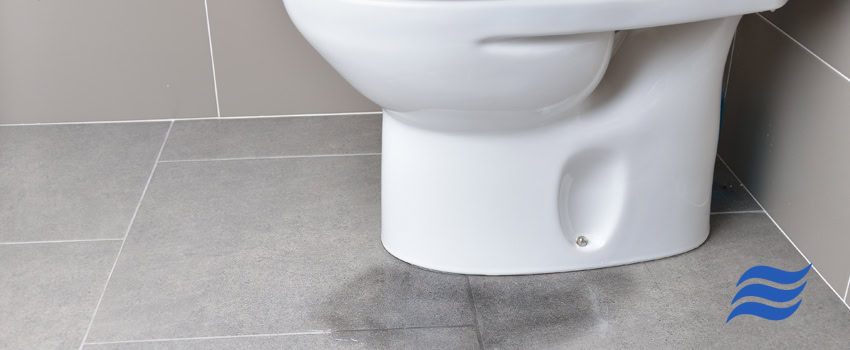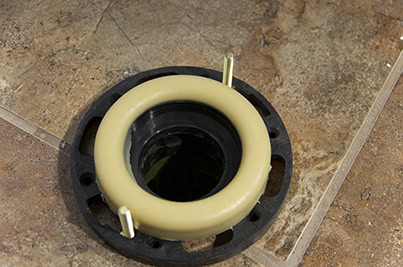
When Toilet Wax Rings Fail
How a Simple Part Can Cost You Thousands
When Sarah heard dripping from her ceiling below the upstairs bathroom, she never imagined toilet wax ring failure could lead to $8,000+ in water damage repairs. Like most homeowners, she'd never heard of a wax ring until it failed, allowing water to slowly leak through her floor and damage the ceiling below with each flush.
Across Northern Virginia, we see this scenario weekly. What makes wax ring failures particularly frustrating? They're almost always preventable with early detection and proper installation.

What Is a Wax Ring and Why Should You Care?
Think of a wax ring like the rubber seal on a mason jar—it creates a watertight barrier between your toilet and the floor drain. This petroleum-based ring sits invisibly beneath your toilet, preventing wastewater from leaking and sewer gases from entering your home.
When it works, you never think about it. When it fails, the consequences hit fast and are expensive.
The Tile Renovation Trap: Why Bathroom Remodels Create Wax Ring Disasters
Here's a scenario we see constantly: A homeowner decides to upgrade their bathroom, replacing old vinyl flooring with beautiful porcelain tile. The contractor carefully removes the toilet, installs backer board and tile, then reinstalls the toilet using the same type of wax ring without adjusting for the new floor height. Within months, water stains appear on the kitchen ceiling below.
What Went Wrong?
The contractor added 1/4″ backer board plus 3/8″ tile, raising the floor height by 5/8″. This dropped the toilet flange 5/8″ below the proper height.
It's like trying to connect two pipes that are now too far apart – the wax ring, designed to seal when the flange sits 1/4″ above the finished floor, could no longer bridge the gap effectively.
One of our customers experienced exactly this. After his master bathroom tile renovation, his toilet began leaking just slightly with each flush, not enough to notice immediately, but enough to slowly saturate the subfloor and eventually damage his kitchen ceiling below. Since it was the master bathroom and not used by the whole household, the water would partially dry between uses, masking the problem until thousands of dollars in damage had occurred.
The frustrating part? This happens during “improvement” projects when homeowners think they're making their homes better.
Why This Happens So Often
Unfortunately, this happens with both professional plumbers and experienced DIYers.
Professional plumbers miss this due to:
- Rushing the job – pressure to complete quickly without proper assessment
- Assuming standard solutions work – using regular 3″ wax rings without measuring new floor heights. Many contractors don't realize that jumbo 4″ rings are specifically designed for larger gaps between the floor and toilet, which commonly occur after renovations.
- Poor communication – not coordinating with the tile contractor about the final floor thickness or discussing which size wax ring will be needed for the new floor height.
- “It'll probably be fine” mentality – hoping a standard wax ring will compensate for poor flange height instead of using the appropriate jumbo size for the gap.
- Lack of accountability – subcontractors who won't be around when problems surface months later.
DIY installers often fail because:
- YouTube University gaps – videos rarely cover flange height complications from renovations
- Overconfidence from past success – “I've installed toilets before” without realizing floor changes everything
- Focus on the obvious – worried about getting the toilet level and bolted down, missing the hidden seal issues
- Hardware store advice limitations – staff may not understand the specific renovation context
- Cost-cutting pressure – trying to reuse the existing setup rather than buying proper extensions
The good news? Whether caused by renovation oversights or everyday wear, wax ring problems give you warning signs before major damage occurs. Here's what to look for:
6 Warning Signs You Can't Ignore
Your toilet rocks or moves when you sit down. A toilet should never shift. Movement breaks the wax seal with every use, and wax rings can't bounce back once compressed.
Water pools around the base after flushing. Place paper towels around your toilet and check them daily. If they keep getting wet, your seal is compromised.
Persistent sewer odors that won't go away with cleaning. A failing seal allows harmful sewer gases into your bathroom.
Black spots or mold around the toilet base indicate ongoing moisture from a leaking seal.
Soft or spongy flooring around the toilet means water has been seeping into your subfloor, potentially for months.
Water stains or discoloration on ceilings below the bathroom indicate water has been leaking long enough to penetrate the flooring and damage rooms below. This is often the first sign homeowners notice, but damage has already begun.
When Small Problems Become Big Disasters
One of our customers had a toilet that “wobbled a little” for six months. He kept meaning to address it but never got around to it. When water stains appeared on his dining room ceiling below, the damage was already extensive:
- Destroyed subfloor requiring complete replacement
- Water damage to the ceiling and walls below
- Mold remediation needed
- Extensive drywall repair and painting
- Bathroom floor replacement
- Proper toilet reinstallation with correct flange height
The original problem? Poor flange height planning during renovation led to wax ring failure that could have been prevented with proper installation.
Why Wax Rings Fail (And Why DIY Often Doesn't Work)
Flange height problems: The #1 cause we see. When flanges sit below floor level (often after renovations), wax rings cannot create proper seals, leading to inevitable failure.
Installation challenges: You get one shot to position the toilet correctly before the wax compresses. Misalignment creates immediate seal problems.
House settlement: Over time, homes shift slightly and toilet bolts loosen, gradually breaking the seal.
Hidden underlying problems: We regularly fix “failed” DIY repairs where homeowners have replaced wax rings multiple times. The real issue? Damaged flanges, soft subfloors, or incorrect toilet mounting that no amount of wax can fix.
Prevention: Plan Before You Renovate
If you're planning a bathroom renovation:
- Discuss toilet flange height with your contractor before starting
- Ensure they understand flanges must sit on top of finished floors
- Budget for flange extension kits if adding significant floor thickness
- Never assume “it'll be fine” with existing flange heights
If you recently renovated and notice any warning signs:
- Don't wait for visible damage
- Have the installation professionally assessed immediately
- Address flange height issues before they cause major damage
Our Professional Approach
When customers call about toilet problems, we don't just swap the wax ring and hope. Our process includes:
- Complete assessment of toilet installation and flange height relative to the finished floor
- Subfloor stability evaluation
- Identification of renovation-related issues that lead to premature failure
- Flange extension installation when needed
- Modern sealing alternatives, when appropriate
This comprehensive approach means our repairs last. We'd rather spend extra time diagnosing the real problem than have you calling us again in six months.
When to Call the Professionals
Don't attempt fixing it yourself if you're experiencing:
- Recurring wax ring failures
- Recent bathroom renovation followed by toilet problems
- A toilet that's been moving since the flooring installation
- Soft flooring around the toilet
- Visible water damage below the bathroom
At Nichols & Phipps, we've prevented countless expensive disasters by catching wax ring problems early, especially those caused by renovation oversights. Our master plumbers have seen just about every wax ring issue imaginable, from tricky installations on uneven floors to complex flange height problems that stump even experienced DIYers. Getting the seal just right can be surprisingly challenging, which is why wax ring leaks are one of the most common calls we receive. Sometimes the best repair is the one that stops a catastrophe before it happens.
Planning a renovation or notice warning signs after one? Don't let a beautiful bathroom upgrade turn into a costly disaster. Call us today at (703) 670-8519 or visit us online to schedule an inspection. Your ceiling—and your wallet—will thank you.
